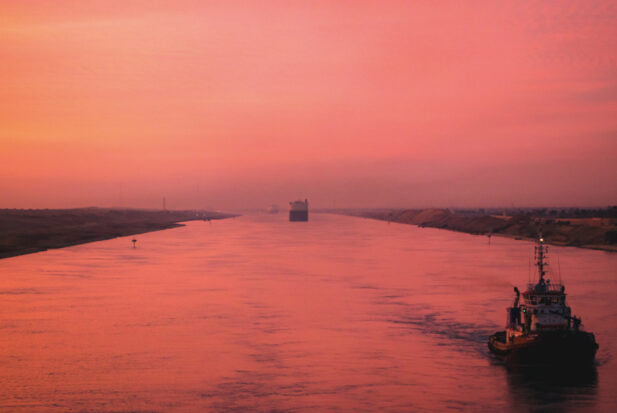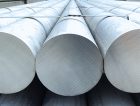
The key trade routes in the Middle East and North Africa include some of the busiest and most difficult-to-navigate maritime chokepoints in the world. The consequences of closure can be dire, as demonstrated by the far-reaching effects for global supply chains when the Ever Given blocked the Suez Canal. Previously beset by piracy and political unrest, climate change now poses a further threat to these waterways. Jenny Messenger takes a closer look at the Suez Canal, the challenges it faces and possible ways around them.
The Suez Canal sits at the crossroads of three continents, linking the Mediterranean and the Red Seas to the Indian Ocean. Since it opened in November 1869, it has become a crucial artery for global trade.
The canal’s round-the-clock traffic is booming, reaching 23,780 ships in 2022, a year-on-year increase of 15%. Last March, it saw an average of 70.21 ships every day, according to maritime agent Leth Agencies.
Along with the Straits of Hormuz and Bab El-Mandeb, it is one of the maritime chokepoints – strategically situated, narrow waterways prone to congestion – crucial for all kinds of trade, including oil shipped from the Arabian Peninsula through to Europe and the US.
Piracy has threatened the canal’s navigability in the past, especially after a spate of attacks in waters off the coast of Somalia, but hijackings have become less common in the past decade after a number of international task forces stepped up their counter-piracy efforts.
Political instability in Egypt was also a cause for concern following the country’s 2011 revolution, and two ships in the Suez Canal were attacked by a militant group in 2013.
But nothing has had a bigger impact in recent years than the canal’s 2021 blockage by the Ever Given, a mammoth container ship carrying just over 20,000 twenty-foot equivalent units.
The 400m-long vessel was wedged for six days and needed a team of tugboats and excavators – and, eventually, the help of the tide – to free it.
In that time, global trade suffered, with goods worth an estimated US$10bn held up each day of the blockage, according to Lloyd’s List tracking data.
Alongside its role in supply chains worldwide, the Suez Canal is also a substantial source of hard currency for Egypt through the transit fees it collects – which is particularly important when the country faces a shortage of US dollars, as it does now.
The impact of climate change
While weather will always be a key factor at sea, some experts are calling increased attention to the growing impact of climate change on the navigability of important waterways.
Sailing through the Suez Canal, “visibility may be decreased due to sand haze, and local winds blow up depending on heat differentials”, says Captain Bill Kavanagh, a lecturer in navigation at the National Maritime College of Ireland with 20 years’ experience at sea.
Initial reports from the Suez Canal Authority (SCA) claimed that high wind speeds and a sandstorm – worsened by a recent heatwave that dried out the soil and made it easier for the winds to whip up dust – prompted the Ever Given to veer off course, though the SCA later added human factors were also at play.
In the days before the grounding, the Egyptian Meteorological Authority issued warnings about a spate of oppressively hot sandstorms known as the khamaseen winds, with some reaching speeds of 46 miles per hour.
According to an article for Yale Climate Connections by meteorologist Jeff Masters, “the large-scale weather pattern responsible for the sandstorm was quite extreme, and climate change could have contributed to make this event more extreme”.
Masters concludes that while connections between the climate crisis and the grounding of the Ever Given remain speculative, “the event serves as a warning that climate change can be expected to cause an increase in extreme events that will impact critical global trade chokepoints”.
A June 2022 Chatham House report analyses the possibility of storm surges in the Red Sea’s Gulf of Suez, an event that has become more likely in recent years, and found that resulting infrastructure damage “could render the canal unnavigable for six weeks while damage is repaired and ships are re-floated”.
Global broker Marsh and Cross Dependency Initiative (XDI), a physical climate risk modelling organisation, have also suggested that the disruptive weather events spurred on by climate change could present problems for the Suez Canal in future.
Their November 2022 report flags a higher risk of coastal inundation (where the sea level rises high enough to flood infrastructure), extreme heat and desertification, noting that temperatures are already 1°C hotter than they were 100 years ago, while annual precipitation has decreased by 22% over the past 30 years.
The report modelled risks at four ports and along the canal waterway in 2020, 2050 and 2100, based on a global average temperature increase of 3.7°C above pre-industrial levels.
While the Ever Given was stuck a few miles north of the city of Suez, near the canal’s southern entrance of Port Tawfiq, the report says that the Suez Canal Container Port in the north has the highest exposure to physical climate-related risks, largely on account of coastal inundation risk, with sea levels projected to rise by 1m by 2100.
“Compared with today, extreme heat events reaching 45°C double by 2050 and are likely to increase seven-fold by 2100,” the report notes, adding that a “confluence” event, in which multiple factors occur at the same time, might have triggered the Ever Given’s grounding.
“With a projected rise in heat, and high wind events continuing to occur, the incident serves as a cautionary tale: with shipping trade typically running on tight time schedules, the propensity for these incidents to cause significant disruption to port services and the logistics chains is high,” the report concludes.
Measures can be taken to shore up the canal’s physical resilience, such as raising or hardening the banks to adapt to rises in sea level.
But there is an added problem: as container ships increase in size, so too does the difficulty in refloating them should they run into trouble. At its narrowest point, the canal is just 200m wide.
Kavanagh says that “the increased size of vessels makes them more difficult to navigate in tight areas without tug assistance”.
“Increased dimensions are the problem. Heavier, deeper, longer and wider ships are more difficult to manoeuvre and results in bank suction and bank rejection which depend on draft and speed,” he adds.
To cope with the quantity and size of ships passing through, the SCA has widened and deepened the canal to enable it to take more marine traffic, reduce waiting times and prepare it for ever-larger ships.
Its most recent widening project is due to be completed this year and involves creating a 35km stretch of new canal to run parallel to the existing one. Local media reports suggest that progress is on track.
The Suez Canal, Kavanagh adds, “is a vital part of the supply chain and deserves the most modern navigation instrumentation available, operated by the most skilful people. A simple grounding or collision has global consequences.”
Alternative routes
If the canal is blocked, there are few viable alternatives by sea. One option is the Cape of Good Hope, but this is a far longer and often far costlier route.
The SCA’s website shows the savings in both distance and time between key ports: travelling via the Suez Canal from Jeddah to Piraeus cuts out 9,887 nautical miles compared to the route using the Cape of Good Hope, while Tokyo to Rotterdam saves 3,315 nautical miles.
In a Q&A published by Allianz Global Corporate & Specialty in the aftermath of the Ever Given’s grounding, the carrier’s global head of marine risk consulting, Rahul Khanna, says that the increase in fuel consumption across a longer journey “is considerably more expensive but the ship can save on Suez Canal fees”.
The SCA increased transit fees for all ships by 15% at the start of 2023, with the exception of dry bulk vessels, which saw a hike of 10%. In a January 2 statement from Egypt’s president Abdel Fattah El-Sisi, chairman of the SCA Osama Rabie is quoted as reporting that 2022 returns had increased by a quarter compared to 2021, reaching “about US$8bn”.
“The weather is another consideration as this can deteriorate while going round the Cape,” Khanna says. “Therefore, it’s not the first route choice for smaller vessels which may not even have the fuel capacity.”
This route also increases a vessel’s carbon emissions. According to a calculation by environmental organisation the Eco Experts, 12 ships known to have rerouted via the tip of Africa generated almost 7,000 extra tonnes of CO2.
Another option, but one that brings with it a different set of problems, is the Arctic Ocean, which is growing more accessible as the Earth warms.
This route shortens the journey time considerably, and involves either taking the Northeast Passage through the Barents and Kara Seas, hugging the coasts of Norway and Russia, or travelling through Canadian waters via the Northwest Passage.
Sailing from Yokohama, just south of Tokyo, to Rotterdam via the Arctic would shave 37% off the trip via the Suez Canal, taking it down to 7,010 nautical miles, according to a calculation by Shaul Chorev, professor at the University of Haifa and a retired Israeli navy rear admiral.
Arctic sea ice is projected to decline over the coming decade, and according to the National Snow and Ice Data Center, the rate of ice decline in 2020 was faster than in previous years.
“This suggests that the timeframe during which exporting can occur while the sea is not fully frozen could potentially lengthen,” says Jin-Ho Yoon, professor of earth sciences and environmental engineering at South Korea’s Gwangju Institute of Science and Technology.
Traders and logistics companies have already tested this route, but it’s far from being commercially viable, and as yet doesn’t appear to pose a significant threat to the Suez Canal.
In 2017, a Russian commercial liquefied natural gas tanker managed to pass from Norway to South Korea without an icebreaker, following a route defined in Russian legislation that overlaps with the Northeast Passage.
And in 2018, Maersk successfully sent the first container ship along the same route, referred to at the time by Reuters as a “mini Suez Canal”.
Robbie Mallett, postdoctoral research fellow at the University of Manitoba, tells GTR that the route is already viable in summer and is becoming increasingly feasible in winter.
Speaking from Antarctica, where he is taking part in a research project exploring the causes and effects of fluctuations in sea ice, Mallett says that in summer it’s possible to travel via the Arctic without an icebreaker, but in winter ice-strengthened vessels are required.
“Barring any legislation changes, Arctic shipping will increase in response to climate change because the floating sea ice will retreat in summer and thin in winter,” Mallett explains.
Arctic warming means that as the area of sea ice retreats, it will be possible to sail the route “without entering either the Canadian or Russian exclusive economic zones. That route is just shorter as well,” Mallett says.
In winter, these routes will be increasingly possible in conventional vessels for longer periods of time, meaning fewer icebreakers will be needed and costs will come down accordingly, he adds.
But this will likely mean that the Arctic has warmed to a worrying degree.
“If ships can navigate this route more easily, indicating an extended period of navigability, it likely signifies that the Earth is experiencing further warming,” Yoon says.
And using this route might have further consequences for the climate.
Possible ramifications, Mallett says, include “the deposition of black carbon on the sea ice. It makes it less reflective to sunlight, so the sea ice absorbs more heat that melts it and further warms the Arctic, which is already warming at four times the global rate.”
Another risk is of fuel spills in ice covered areas: “we’re simply not prepared to deal with this should it occur, and the environmental and ecological consequences would be totally devastating”, he says, adding that other potential consequences include the introduction of invasive species to Arctic waters and geopolitical conflicts with Russia due to increased Arctic Ocean traffic.
So far, it seems the Suez Canal remains the best option for many companies, but as the effects of climate change continue to be felt, the shape of shipping routes could well change – bringing with it new challenges for global trade.










